Abstract
Objective:
To investigate quadriceps strength and static and dynamic balance in the anterior cruciate ligament (ACL)-reconstructed patient and to compare these findings with an age-matched, injury-free control group.
Design and Setting:
A 2 × 2 mixed-design analysis of variance (group × leg) was applied to the static posture, dynamic balance, and strength data. In addition, Pearson product-moment correlations were calculated to determine the strength of the relationships among the dependent measures. All data were collected in the Motor Control Laboratory at Indiana University.
Subjects:
The experimental group was composed of 20 individuals who had undergone ACL reconstruction with a patellar tendon autograft. The control group comprised 20 participants with no history of significant orthopaedic injuries to the lower extremities.
Measurements:
The dependent variables were sway path linear mean for the static condition, dynamic-phase recovery time after perturbation for the dynamic measure, and quadriceps peak torque for strength.
Results:
We found significant differences between the ACL and control groups on the measures of dynamic-phase duration and peak torque. The static sway variable did not show a significant difference.
Conclusions:
Evaluation of the postural control system under 2 conditions, static and dynamic, showed differences between the ACL and control groups for the dynamic condition only. These results suggest the presence of independent control mechanisms for the control of static and more dynamic postures. In addition, because there were no differences between the injured and noninjured legs of the ACL group, the theory of a central postural control scheme is supported.
Keywords: balance, posture
Full text
PDF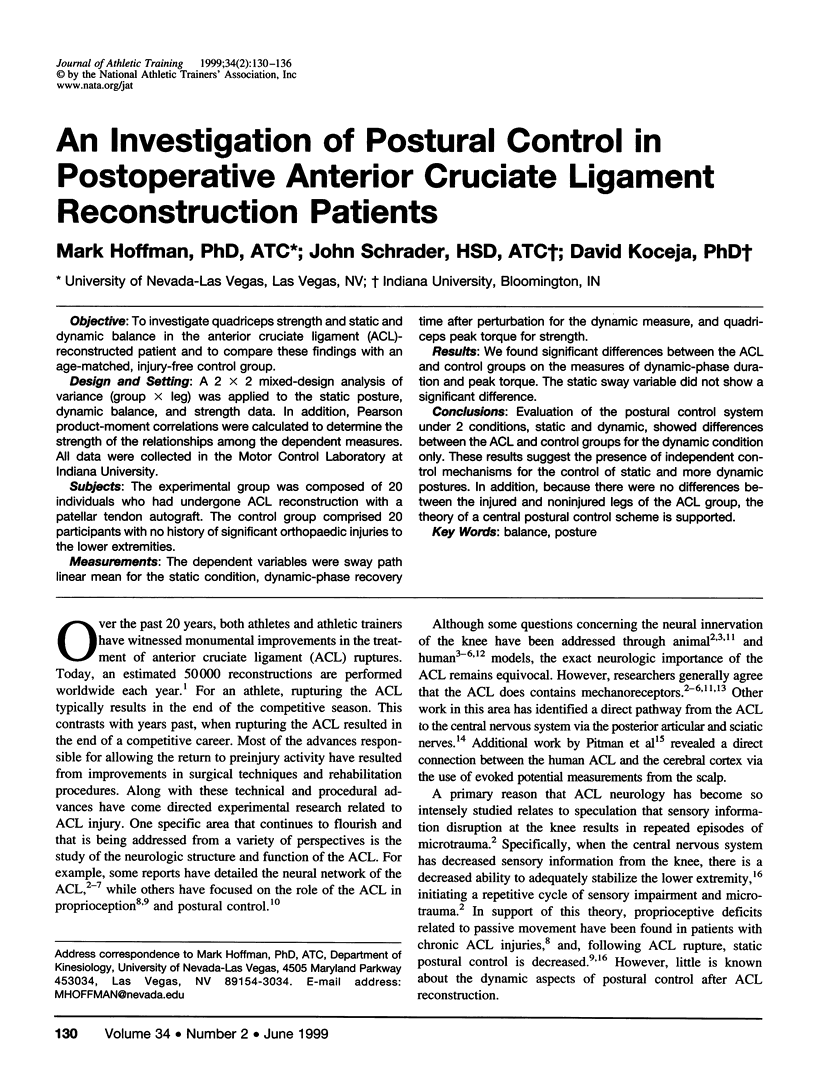
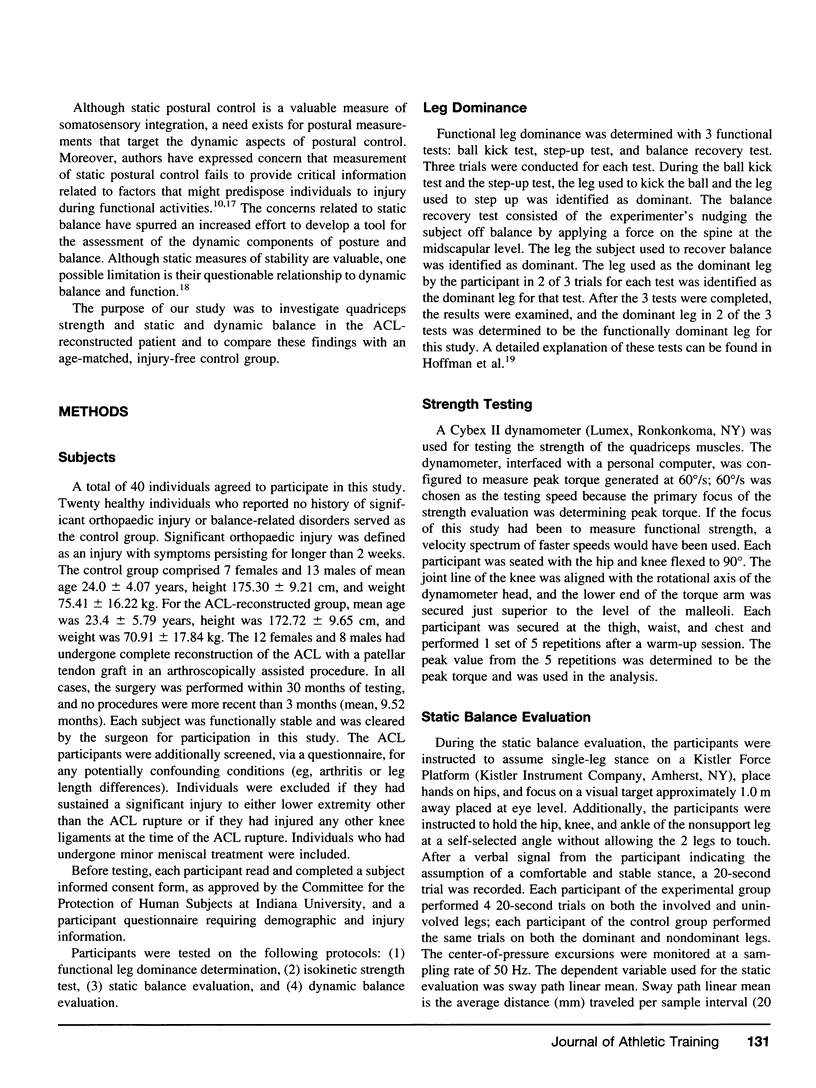
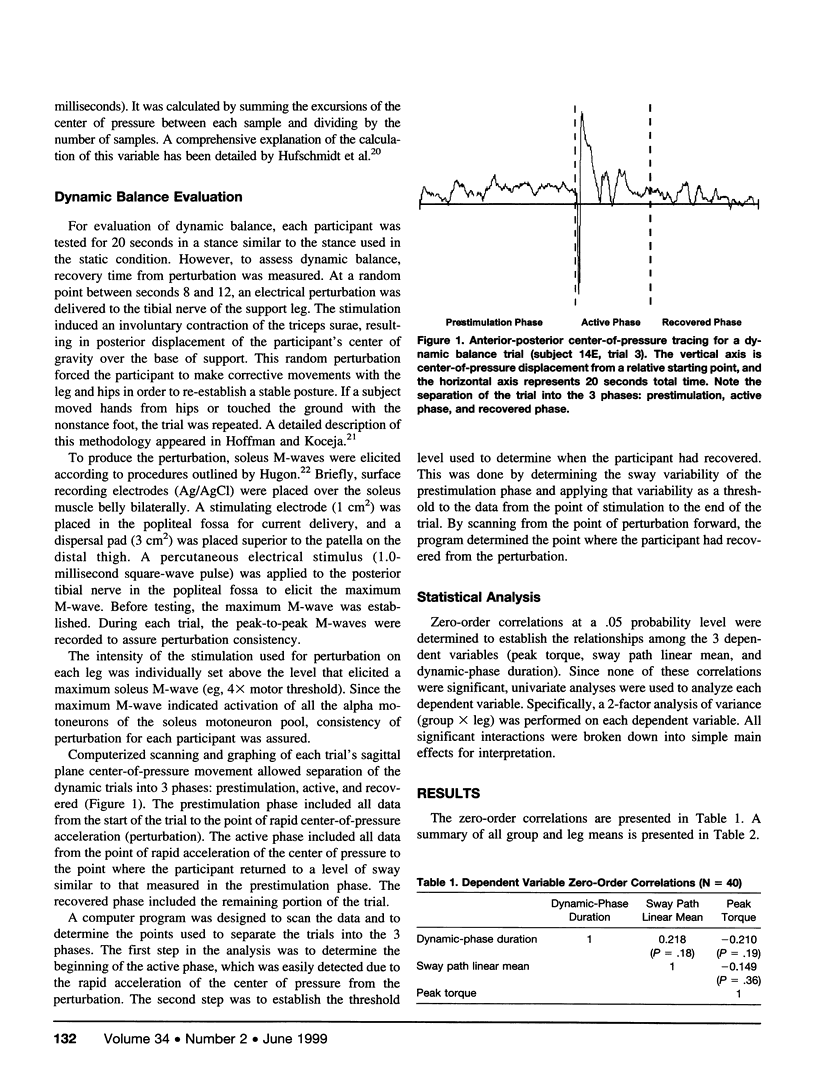
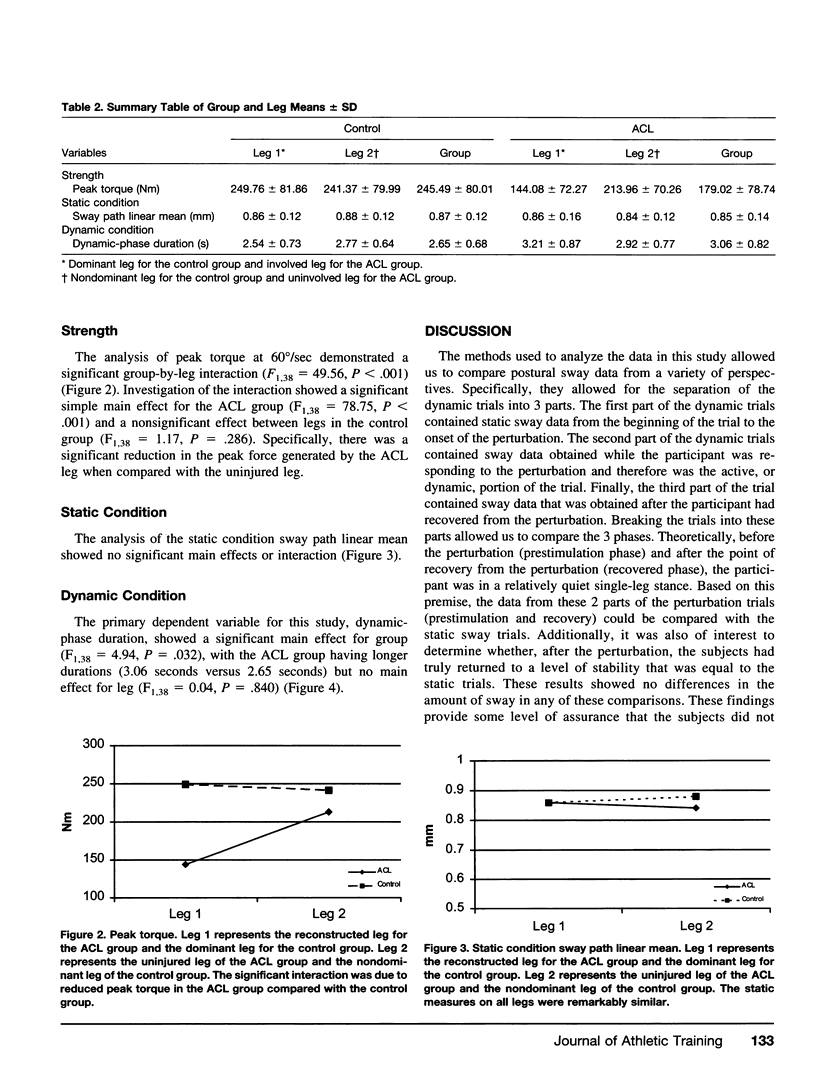
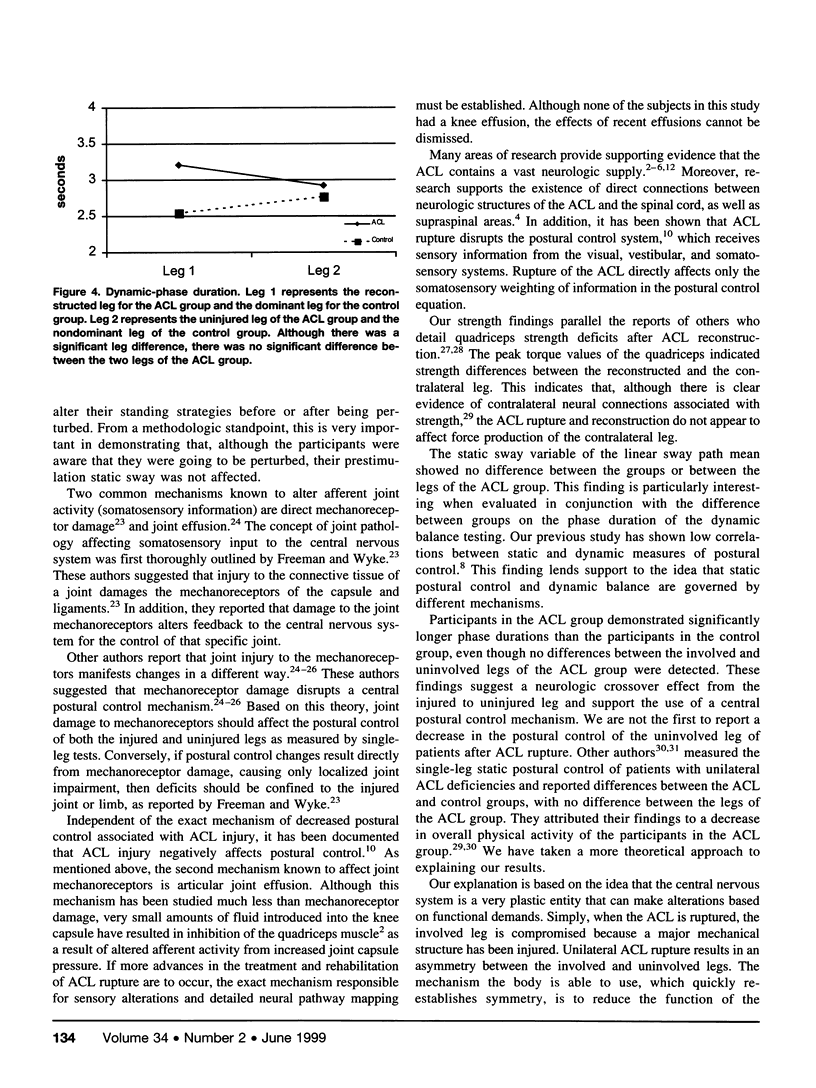
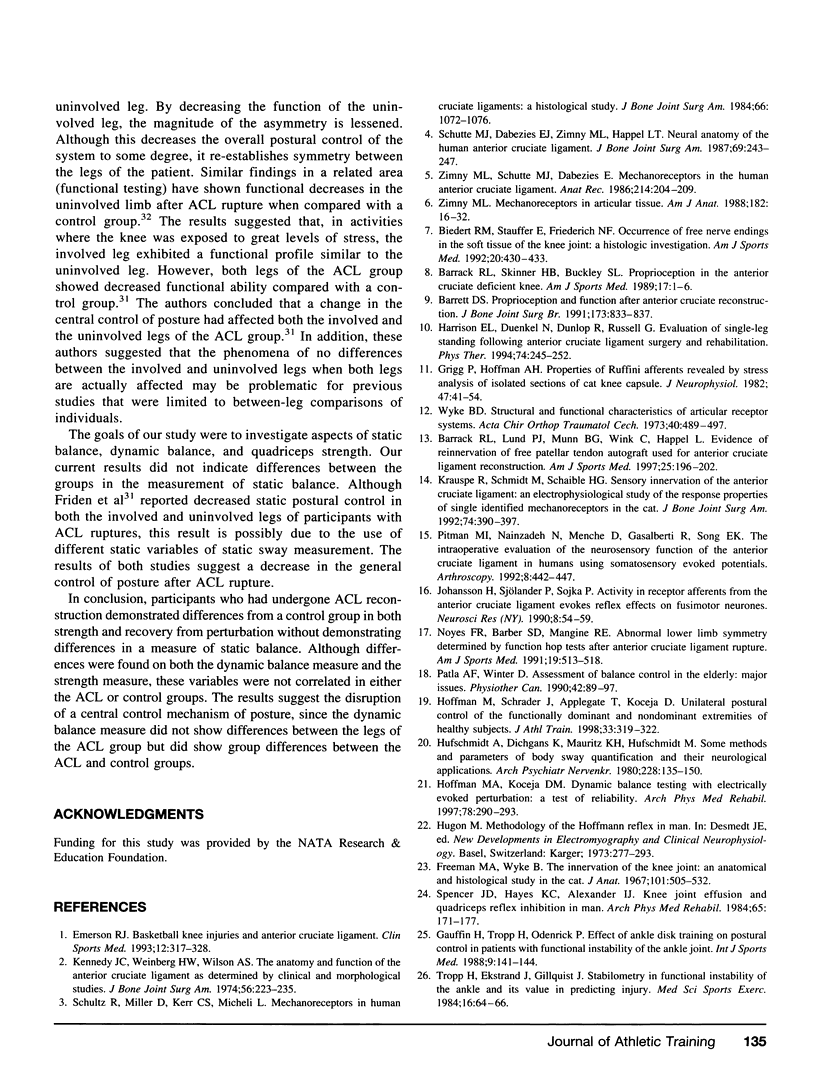
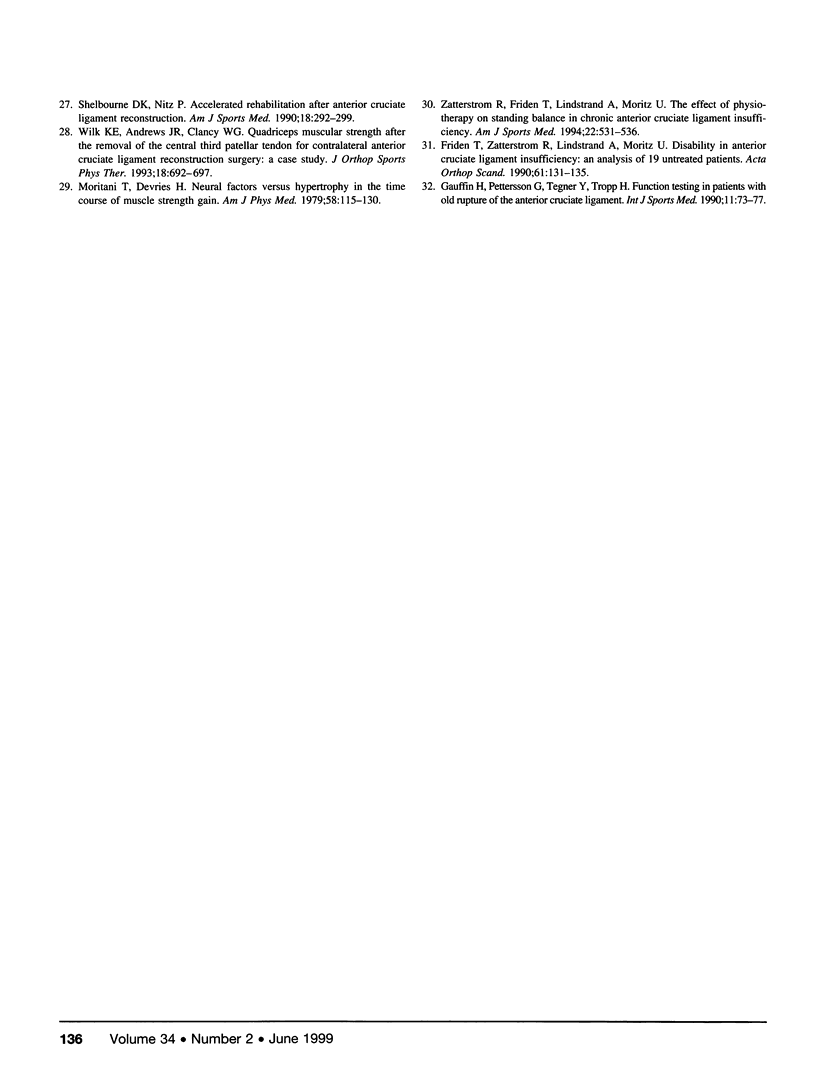
Selected References
These references are in PubMed. This may not be the complete list of references from this article.
- Barrack R. L., Lund P. J., Munn B. G., Wink C., Happel L. Evidence of reinnervation of free patellar tendon autograft used for anterior cruciate ligament reconstruction. Am J Sports Med. 1997 Mar-Apr;25(2):196–202. doi: 10.1177/036354659702500210. [DOI] [PubMed] [Google Scholar]
- Barrack R. L., Skinner H. B., Buckley S. L. Proprioception in the anterior cruciate deficient knee. Am J Sports Med. 1989 Jan-Feb;17(1):1–6. doi: 10.1177/036354658901700101. [DOI] [PubMed] [Google Scholar]
- Barrett D. S. Proprioception and function after anterior cruciate reconstruction. J Bone Joint Surg Br. 1991 Sep;73(5):833–837. doi: 10.1302/0301-620X.73B5.1894677. [DOI] [PubMed] [Google Scholar]
- Biedert R. M., Stauffer E., Friederich N. F. Occurrence of free nerve endings in the soft tissue of the knee joint. A histologic investigation. Am J Sports Med. 1992 Jul-Aug;20(4):430–433. doi: 10.1177/036354659202000411. [DOI] [PubMed] [Google Scholar]
- Emerson R. J. Basketball knee injuries and the anterior cruciate ligament. Clin Sports Med. 1993 Apr;12(2):317–328. [PubMed] [Google Scholar]
- Freeman M. A., Wyke B. The innervation of the knee joint. An anatomical and histological study in the cat. J Anat. 1967 Jun;101(Pt 3):505–532. [PMC free article] [PubMed] [Google Scholar]
- Fridén T., Zätterström R., Lindstrand A., Moritz U. Disability in anterior cruciate ligament insufficiency. An analysis of 19 untreated patients. Acta Orthop Scand. 1990 Apr;61(2):131–135. doi: 10.3109/17453679009006504. [DOI] [PubMed] [Google Scholar]
- Gauffin H., Pettersson G., Tegner Y., Tropp H. Function testing in patients with old rupture of the anterior cruciate ligament. Int J Sports Med. 1990 Feb;11(1):73–77. doi: 10.1055/s-2007-1024766. [DOI] [PubMed] [Google Scholar]
- Gauffin H., Tropp H., Odenrick P. Effect of ankle disk training on postural control in patients with functional instability of the ankle joint. Int J Sports Med. 1988 Apr;9(2):141–144. doi: 10.1055/s-2007-1024996. [DOI] [PubMed] [Google Scholar]
- Grigg P., Hoffman A. H. Properties of Ruffini afferents revealed by stress analysis of isolated sections of cat knee capsule. J Neurophysiol. 1982 Jan;47(1):41–54. doi: 10.1152/jn.1982.47.1.41. [DOI] [PubMed] [Google Scholar]
- Harrison E. L., Duenkel N., Dunlop R., Russell G. Evaluation of single-leg standing following anterior cruciate ligament surgery and rehabilitation. Phys Ther. 1994 Mar;74(3):245–252. doi: 10.1093/ptj/74.3.245. [DOI] [PubMed] [Google Scholar]
- Hoffman M. A., Koceja D. M. Dynamic balance testing with electrically evoked perturbation: a test of reliability. Arch Phys Med Rehabil. 1997 Mar;78(3):290–293. doi: 10.1016/s0003-9993(97)90036-8. [DOI] [PubMed] [Google Scholar]
- Hoffman M., Schrader J., Applegate T., Koceja D. Unilateral postural control of the functionally dominant and nondominant extremities of healthy subjects. J Athl Train. 1998 Oct;33(4):319–322. [PMC free article] [PubMed] [Google Scholar]
- Hufschmidt A., Dichgans J., Mauritz K. H., Hufschmidt M. Some methods and parameters of body sway quantification and their neurological applications. Arch Psychiatr Nervenkr (1970) 1980;228(2):135–150. doi: 10.1007/BF00365601. [DOI] [PubMed] [Google Scholar]
- Johansson H., Sjölander P., Sojka P. Activity in receptor afferents from the anterior cruciate ligament evokes reflex effects on fusimotor neurones. Neurosci Res. 1990 Apr;8(1):54–59. doi: 10.1016/0168-0102(90)90057-l. [DOI] [PubMed] [Google Scholar]
- Kennedy J. C., Weinberg H. W., Wilson A. S. The anatomy and function of the anterior cruciate ligament. As determined by clinical and morphological studies. J Bone Joint Surg Am. 1974 Mar;56(2):223–235. [PubMed] [Google Scholar]
- Krauspe R., Schmidt M., Schaible H. G. Sensory innervation of the anterior cruciate ligament. An electrophysiological study of the response properties of single identified mechanoreceptors in the cat. J Bone Joint Surg Am. 1992 Mar;74(3):390–397. [PubMed] [Google Scholar]
- Moritani T., deVries H. A. Neural factors versus hypertrophy in the time course of muscle strength gain. Am J Phys Med. 1979 Jun;58(3):115–130. [PubMed] [Google Scholar]
- Noyes F. R., Barber S. D., Mangine R. E. Abnormal lower limb symmetry determined by function hop tests after anterior cruciate ligament rupture. Am J Sports Med. 1991 Sep-Oct;19(5):513–518. doi: 10.1177/036354659101900518. [DOI] [PubMed] [Google Scholar]
- Pitman M. I., Nainzadeh N., Menche D., Gasalberti R., Song E. K. The intraoperative evaluation of the neurosensory function of the anterior cruciate ligament in humans using somatosensory evoked potentials. Arthroscopy. 1992;8(4):442–447. doi: 10.1016/0749-8063(92)90005-v. [DOI] [PubMed] [Google Scholar]
- Schultz R. A., Miller D. C., Kerr C. S., Micheli L. Mechanoreceptors in human cruciate ligaments. A histological study. J Bone Joint Surg Am. 1984 Sep;66(7):1072–1076. [PubMed] [Google Scholar]
- Schutte M. J., Dabezies E. J., Zimny M. L., Happel L. T. Neural anatomy of the human anterior cruciate ligament. J Bone Joint Surg Am. 1987 Feb;69(2):243–247. [PubMed] [Google Scholar]
- Shelbourne K. D., Nitz P. Accelerated rehabilitation after anterior cruciate ligament reconstruction. Am J Sports Med. 1990 May-Jun;18(3):292–299. doi: 10.1177/036354659001800313. [DOI] [PubMed] [Google Scholar]
- Spencer J. D., Hayes K. C., Alexander I. J. Knee joint effusion and quadriceps reflex inhibition in man. Arch Phys Med Rehabil. 1984 Apr;65(4):171–177. [PubMed] [Google Scholar]
- Tropp H., Ekstrand J., Gillquist J. Stabilometry in functional instability of the ankle and its value in predicting injury. Med Sci Sports Exerc. 1984;16(1):64–66. [PubMed] [Google Scholar]
- Wilk K. E., Andrews J. R., Clancy W. G. Quadriceps muscular strength after removal of the central third patellar tendon for contralateral anterior cruciate ligament reconstruction surgery: a case study. J Orthop Sports Phys Ther. 1993 Dec;18(6):692–697. doi: 10.2519/jospt.1993.18.6.692. [DOI] [PubMed] [Google Scholar]
- Wyke B. D. Strukturální a funkcní charakteristika kloubního receptorového aparátu. Acta Chir Orthop Traumatol Cech. 1973 Dec;40(6):489–497. [PubMed] [Google Scholar]
- Zimny M. L. Mechanoreceptors in articular tissues. Am J Anat. 1988 May;182(1):16–32. doi: 10.1002/aja.1001820103. [DOI] [PubMed] [Google Scholar]
- Zimny M. L., Schutte M., Dabezies E. Mechanoreceptors in the human anterior cruciate ligament. Anat Rec. 1986 Feb;214(2):204–209. doi: 10.1002/ar.1092140216. [DOI] [PubMed] [Google Scholar]
- Zätterström R., Fridén T., Lindstrand A., Moritz U. The effect of physiotherapy on standing balance in chronic anterior cruciate ligament insufficiency. Am J Sports Med. 1994 Jul-Aug;22(4):531–536. doi: 10.1177/036354659402200416. [DOI] [PubMed] [Google Scholar]


